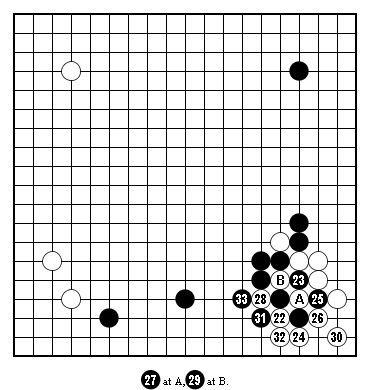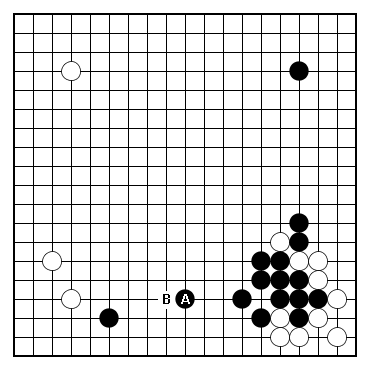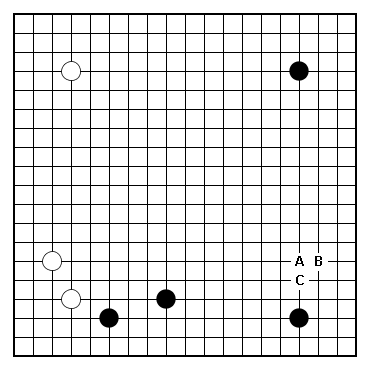Kobayashi fuseki approach "rule of thumb"
Dia 1 shows a typical "Kobayashi fuseki", named after Kobayashi Koichi: it is about Black's lower side, where Black is making an extension at move 7 before making a shimari in the lower right. Actually black 7 can also be one point at the left, in the triangle marked location.
My rule of thumb is to play A with White if Black 7 is just like in Dia 1, and to play B with White if Black 7 is in the triangle location instead.
The rest of this article is explaining what are my reasons for doing so.
 Dia 1
Dia 1
The general idea for Black in a Kobayashi fuseki is to invite White to approach in the bottom right, so that Black attacks White and builds territory while doing that - it is somewhat similar to the Chinese fuseki in this respect.
Since Black is so strong on the lower side, I choose either A or B as an approach for White - since C or D invite White to attack strongly. This is not a dogma: both C and D have been played over time (D being the more popular choice between the 2), but to follow the fundamentals of Go I just play A or B, depending on the location for Black 7.
Dia 2 and Dia 3 show a pretty complicated but popular joseki after White played the low large approach. (This joseki is worth studying in itself to learn about sacrifice techniques: Black is the first to sacrifice one stone, then White returns the favor by sacrificing three stones - but that's not the purpose of this article. Just jump to Dia 4 if you want to skip the joseki details and follow the main story line.)
 Dia 2
Dia 2
 Dia 3
Dia 3
Dia 4 shows the position after the joseki is over: this is a classical territory vs thickness trade-off. It doesn't look good for black though in this case: Black's stone A on the middle of the lower side is too close to Black's own thickness: it would have been much better at B instead. White can even invade later in between A and the other black stone in the lower-left... (Of course, black doesn't have to - and shouldn't! - play this joseki.)
 Dia 4
Dia 4
What if Black wants to play this joseki, and chooses a variation of the "Kobayashi fuseki", as in Dia 5, where Black's middle stone on the lower side is one point to the left, compared to Dia 1? Well, in this White can choose something else to start with: I always play A with White in Dia 4, not B.
By the way, this is more a matter of personal preference: my games database shows B as the most popular follow up for White in Dia 5, with C second popular, A being only third.
 Dia 5
Dia 5
I like to have some rules of thumb for common fuseki situations - this is especially good in competitive Go, when one wants to spend most of the thinking time in the middle game, not in fuseki.
